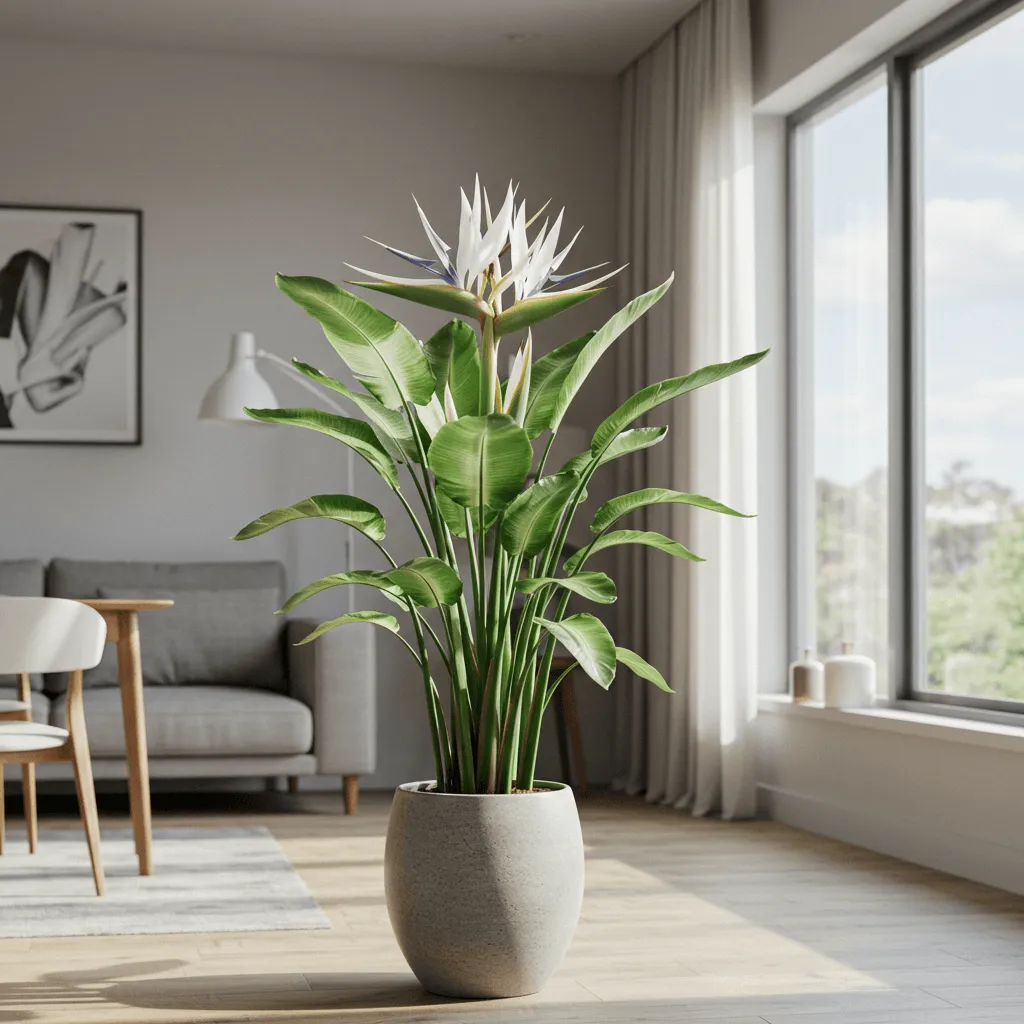The White Bird of Paradise (Strelitzia nicolai) is a stunning tropical plant known for its large, banana-like leaves and striking resemblance to a bird in flight. This elegant plant thrives both indoors and outdoors, making it a favorite among plant enthusiasts and landscapers. With the right care, it can grow several feet tall, bringing a lush, exotic feel to any space.
Whether you’re looking to add a bold statement piece to your indoor garden or enhance your outdoor landscape, learning how to properly grow and care for a White Bird of Paradise is essential. In this guide, we’ll cover everything from ideal growing conditions to common problems and propagation tips to help you keep your plant healthy and thriving.
Let’s dive into the world of the White Bird of Paradise and discover how you can grow this tropical beauty with ease!
Understanding the White Bird of Paradise Plant
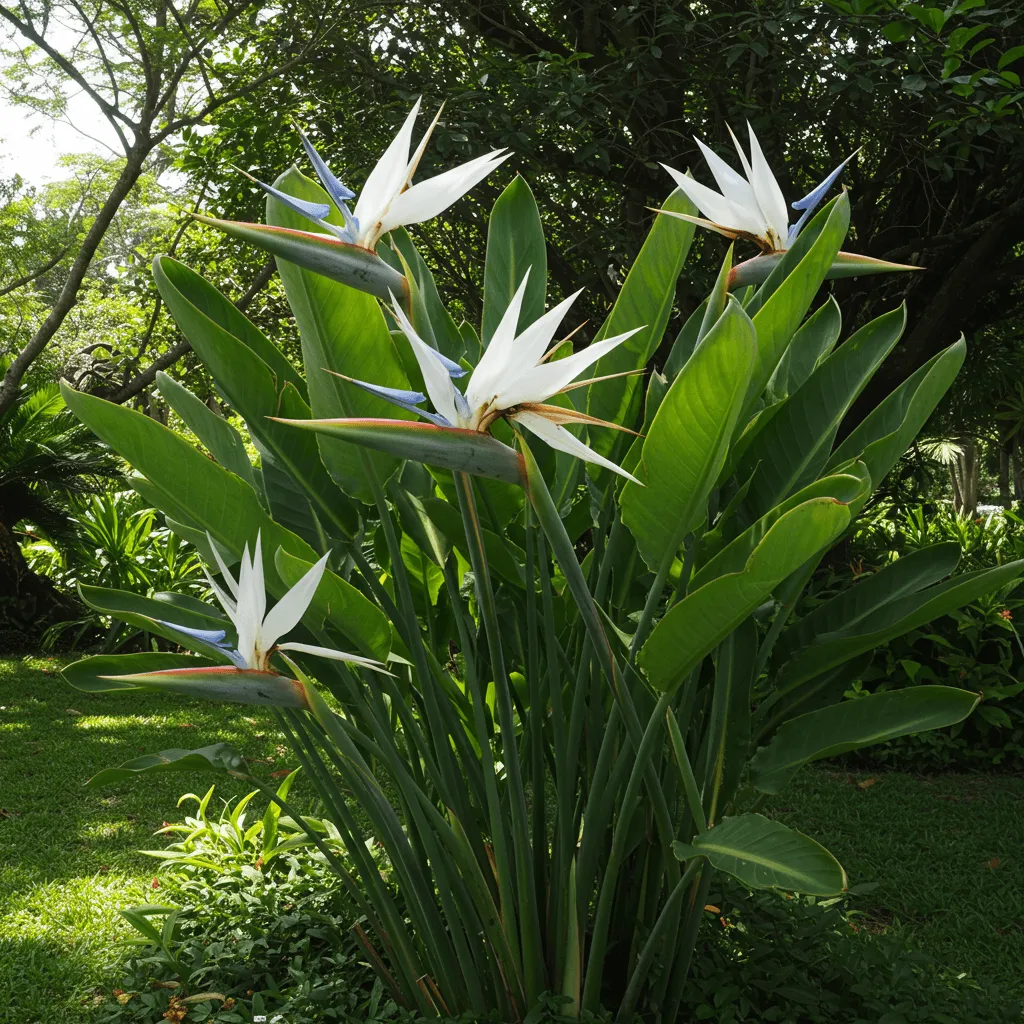
What is a White Bird of Paradise? (Strelitzia nicolai vs. Strelitzia reginae)
The White Bird of Paradise (Strelitzia nicolai) is a tropical plant native to South Africa, prized for its large, lush foliage and striking resemblance to a bird in flight. It belongs to the same family as the Orange Bird of Paradise (Strelitzia reginae), but there are key differences between the two.
- Strelitzia nicolai (White Bird of Paradise) grows much larger, reaching up to 20 feet outdoors and around 6-7 feet indoors. Its flowers are white with a blue tongue and appear on mature plants in outdoor conditions.
- Strelitzia reginae (Orange Bird of Paradise) is smaller, typically growing up to 5 feet tall, and produces vibrant orange and blue flowers, making it more visually similar to an actual bird.
While both plants are stunning additions to any space, Strelitzia nicolai is the better choice for those looking for a grand, tropical feel with large, bold leaves.
Growth Habits and Appearance (Size, Leaves, and Flowers)
The White Bird of Paradise is an evergreen perennial that thrives in warm climates. It has:
- Large, banana-like leaves that can grow up to 3 feet long, adding a tropical touch to homes and gardens.
- A clumping growth habit, where new shoots emerge from the base, gradually expanding its size.
- White and blue flowers that resemble a bird’s head, but these blooms are rare in indoor conditions and typically appear only on mature outdoor plants.
Indoor vs. Outdoor Growth (Best Conditions for Each Setting)
The White Bird of Paradise can be grown both indoors and outdoors, but its care needs vary depending on the environment.
-
Indoor Growth:
- Prefers bright, indirect light or direct sunlight for a few hours daily.
- Thrives in warm temperatures (65-85°F) and high humidity.
- Requires a well-draining potting mix and a container with drainage holes.
- Can grow up to 6-7 feet tall, making it a striking houseplant.
-
Outdoor Growth:
- Does best in USDA zones 9-12, where temperatures stay above 50°F year-round.
- Prefers full sun to partial shade, growing taller and fuller outdoors.
- Requires rich, well-draining soil and occasional fertilization.
- Can reach heights of 15-20 feet, making it an excellent landscape plant.
Whether indoors or outdoors, providing the right conditions will help your White Bird of Paradise thrive, creating a lush, tropical atmosphere in your home or garden.
How to Grow a White Bird of Paradise Plant
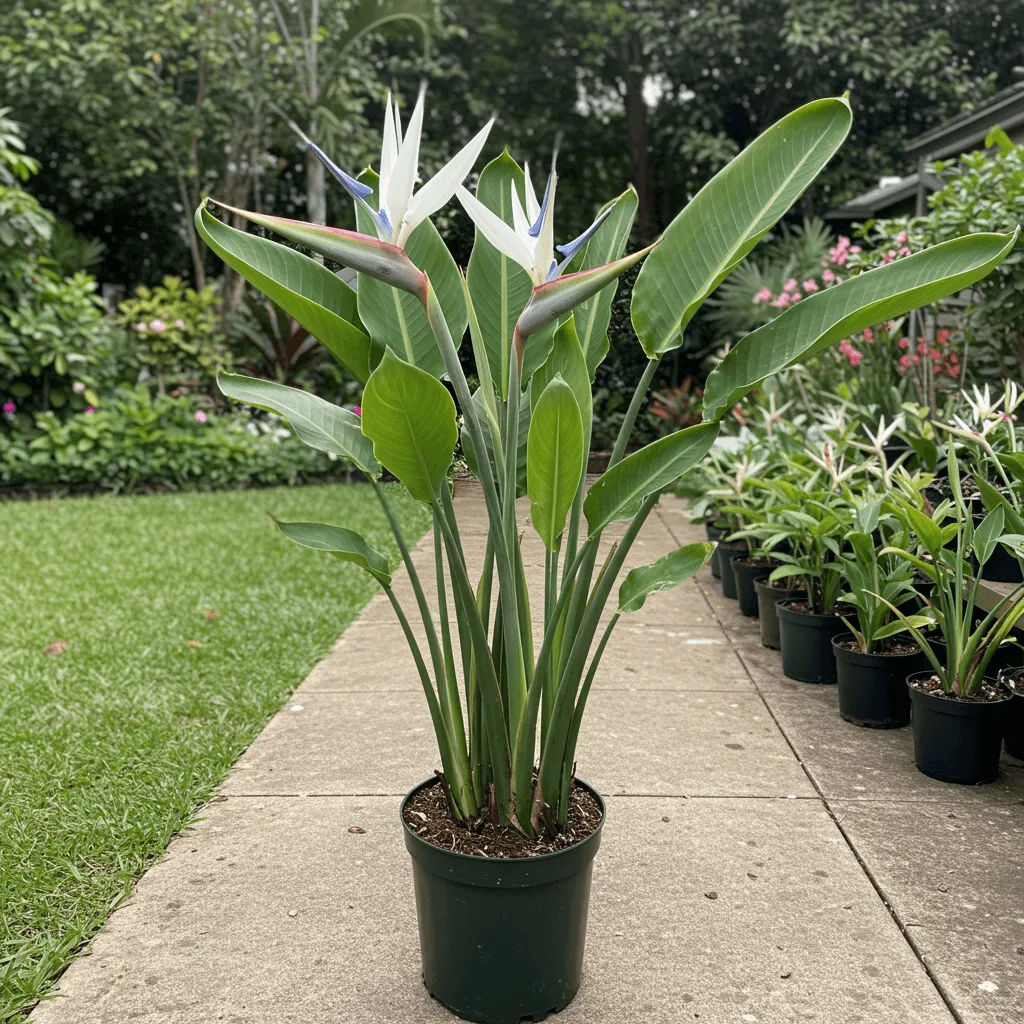
Best Soil and Potting Mix (Drainage Requirements and Nutrients)
A well-draining soil mix is essential for a healthy White Bird of Paradise. The plant thrives in rich, organic soil that holds moisture but drains well to prevent root rot.
- Use a potting mix with peat, perlite, and sand for improved drainage.
- A loamy soil with organic compost works best for outdoor plants.
- Ensure the pot has drainage holes to prevent water buildup.
Light and Temperature Needs (Sunlight Requirements, Ideal Temperature)
The White Bird of Paradise loves bright, direct sunlight and warm temperatures.
- Indoors: Place near a south- or west-facing window with at least 6 hours of bright light daily. It can tolerate low light, but growth may slow.
- Outdoors: Prefers full sun to partial shade for optimal growth.
- Ideal temperature range: 65-85°F (18-29°C). Avoid temperatures below 50°F (10°C) to prevent damage.
Watering Schedule (How Often to Water and Avoid Overwatering)
Overwatering is one of the most common issues with White Bird of Paradise care.
- Water when the top 2 inches of soil feel dry.
- During spring and summer, water once a week or more if it’s hot.
- In fall and winter, reduce watering to every 2-3 weeks.
- Ensure excess water drains properly to prevent root rot.
Fertilizing for Healthy Growth (Best Fertilizers and Frequency)
Regular feeding helps the White Bird of Paradise grow lush and vibrant.
- Use a balanced liquid fertilizer (10-10-10 or 20-20-20) every 2-4 weeks during spring and summer.
- Reduce feeding in fall and stop in winter when the plant enters dormancy.
- For outdoor plants, use slow-release granular fertilizer at the beginning of the growing season.
Essential Care Tips for a Thriving White Bird of Paradise
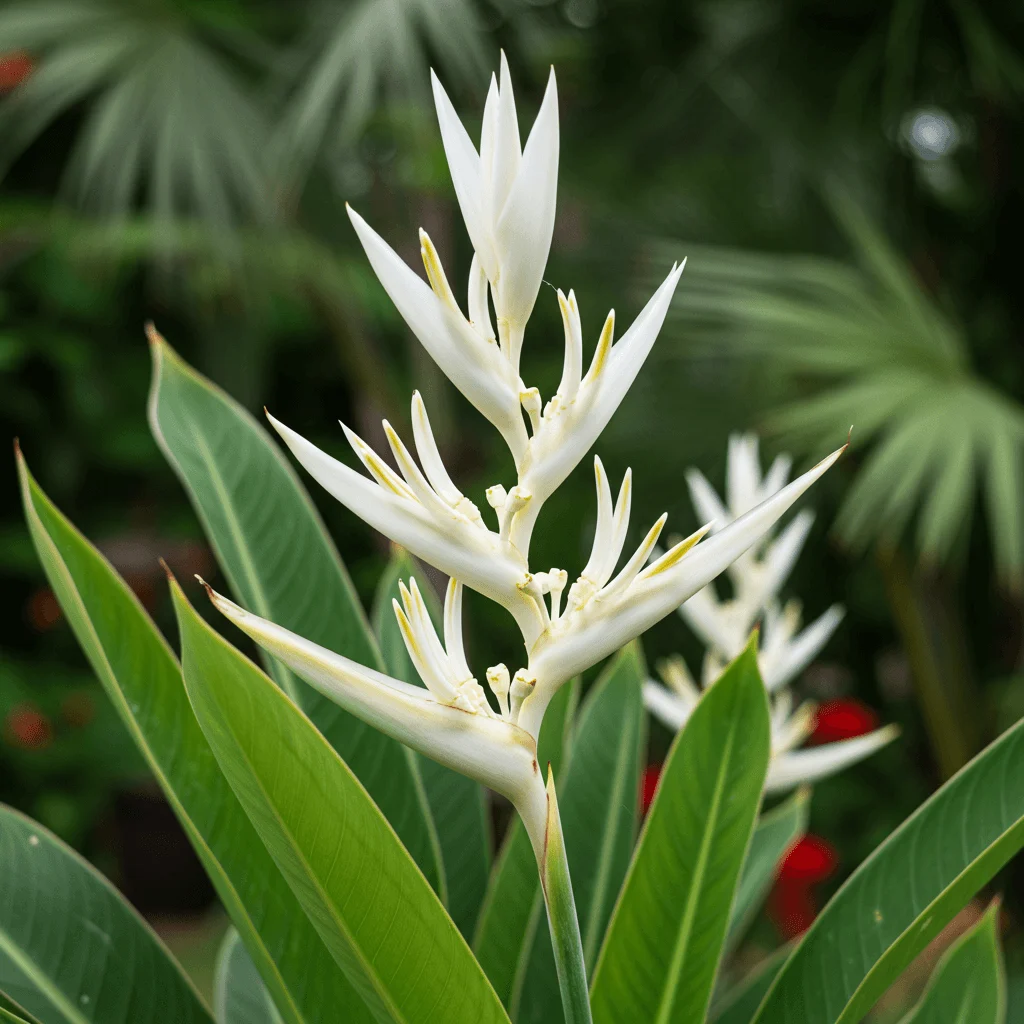
Pruning and Maintenance (When and How to Trim for Better Growth)
Pruning helps remove damaged leaves and encourages new growth.
- Trim yellow or brown leaves at the base using clean, sharp scissors.
- Remove dead or damaged stems to promote air circulation.
- Prune in early spring or summer for the best results.
Repotting Guide (Signs Your Plant Needs a Bigger Pot)
White Bird of Paradise plants grow quickly and may become root-bound.
- Repot every 2-3 years or when roots start growing out of the pot.
- Choose a pot 2 inches larger than the current one with good drainage.
- Use fresh potting mix to provide new nutrients.
Humidity and Air Circulation (How to Maintain Tropical Conditions Indoors)
Being a tropical plant, the White Bird of Paradise prefers high humidity.
- Keep humidity levels at 50-60% for optimal growth.
- Mist the leaves once or twice a week or use a humidifier.
- Place the plant near other houseplants to create a humid microclimate.
Common Problems and How to Fix Them
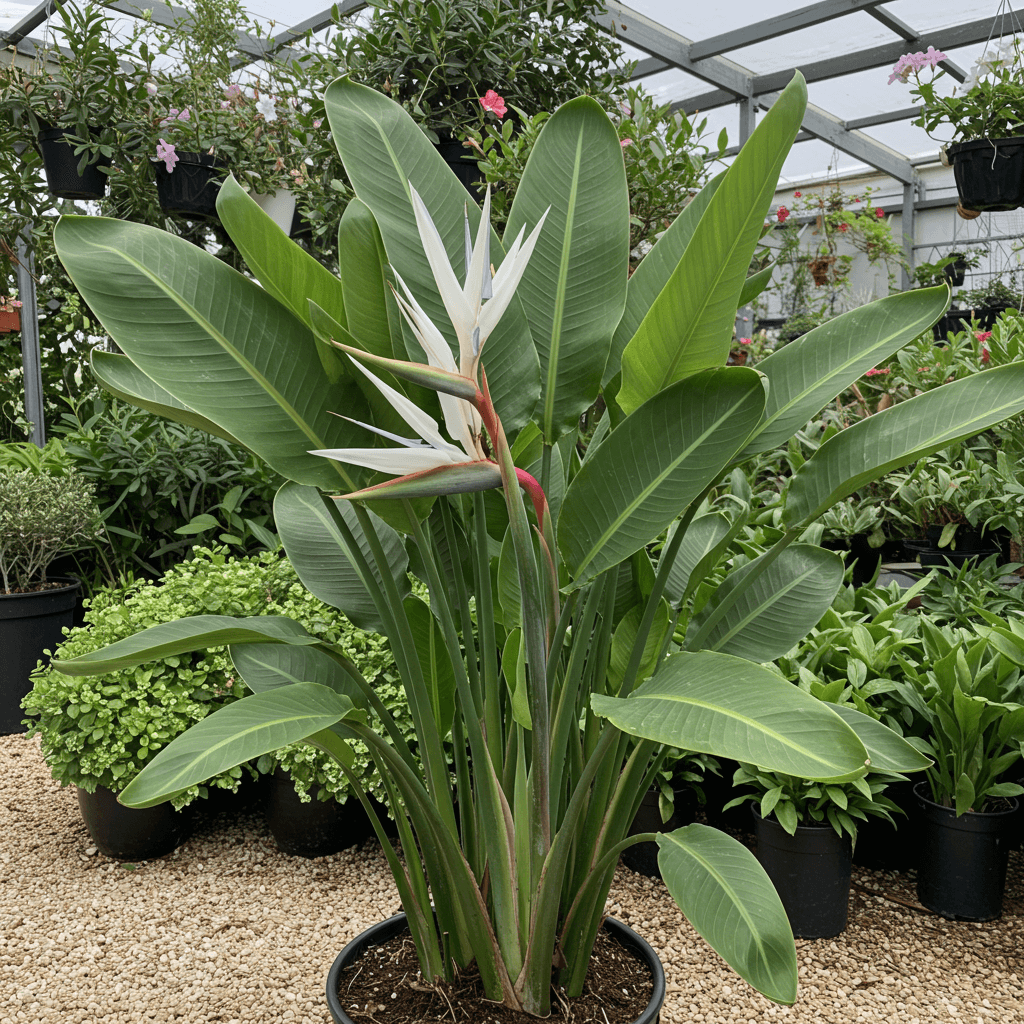
Yellowing or Drooping Leaves (Causes and Solutions)
If leaves turn yellow or droop, it could be due to:
- Overwatering → Reduce watering and check for root rot.
- Underwatering → Increase watering, especially in hot weather.
- Lack of light → Move the plant to a brighter location.
Brown Tips on Leaves (Lack of Humidity, Overwatering, or Fertilizer Issues)
Brown leaf tips are often a sign of stress:
- Low humidity → Increase moisture using a humidifier or misting.
- Too much fertilizer → Flush the soil with water to remove salt buildup.
- Improper watering → Stick to a consistent schedule and avoid waterlogged soil.
Pests and Diseases (Spider Mites, Scale, and Fungal Problems)
Common pests and diseases include:
- Spider mites & scale insects → Wipe leaves with neem oil or insecticidal soap.
- Root rot (from overwatering) → Trim infected roots and repot in fresh soil.
- Fungal infections → Improve air circulation and avoid getting water on the leaves.
Propagating White Bird of Paradise
Can You Propagate White Bird of Paradise? (Division Method)
Yes, White Bird of Paradise is propagated through division, as it does not grow well from cuttings.
- Best for mature plants with multiple stems.
- The division method allows you to separate rooted offshoots from the main plant.
Step-by-Step Propagation Process (How to Divide and Replant)
- Gently remove the plant from its pot and shake off excess soil.
- Identify offshoots (sections with their own roots).
- Use a sharp knife to cut a section away from the main plant.
- Replant each division in a separate pot with fresh soil.
- Water thoroughly and place in bright, indirect light.
Best Time to Propagate for Success (Season and Plant Maturity)
- Best time: Spring or early summer, when the plant is actively growing.
- Ensure divisions have at least 2-3 healthy leaves and strong roots.
For a step-by-step guide, check out this How To Propagate Your White Bird of Paradise
Conclusion
The White Bird of Paradise is a low-maintenance yet striking tropical plant that can thrive with the right care. By providing proper sunlight, watering, and humidity, you can enjoy its lush foliage year-round.
- Key takeaways: Use well-draining soil, bright light, and consistent watering for healthy growth.
- Keep an eye on common problems like yellowing leaves and pests, and take quick action to fix them.
- If you love this plant, try propagating it through division for even more tropical beauty!

